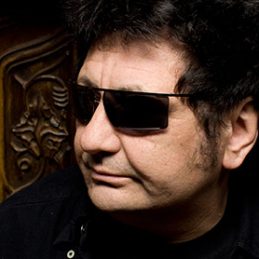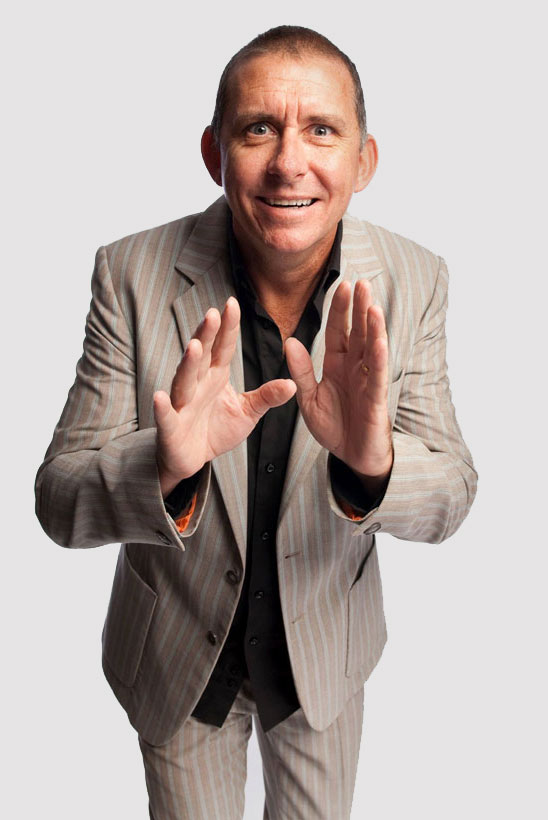About Richard
Richard Clapton (born 18 May 1951) is an Australian singer-songwriter, producer and guitarist from Sydney, New South Wales. His solo top 20 hits on the Kent Music Report Singles Chart are “Girls on the Avenue” (1975) and “I Am an Island” (1982). His top 20 albums on the related Albums Chart are Goodbye Tiger (1977), Hearts on the Nightline (1979), The Great Escape (1982), and The Very Best of Richard Clapton (1982). As a producer, he worked on the second INXS album, Underneath the Colours (1981). In 1983, he briefly joined The Party Boys for a tour of eastern Australia and the live album, Greatest Hits (Of Other People) (1983) before resuming his solo career.
Australian rock music historian Ian McFarlane described Clapton as “one of the most important Australian songwriters of the 1970s”. On 12 October 1999, Clapton was inducted into the Australian Recording Industry Association (ARIA) Hall of Fame. On 1 August 2014 Clapton published his autobiography, The Best Years of Our Lives.
Early years
Richard Clapton’s year of birth is elusive: in a 2002 interview with a Melbourne newspaper, The Age, he described himself as being 50-something. An article in Who magazine (1996) gives his birth year as 1951, while Ian McFarlane’s Encyclopaedia of Australian Rock and Pop (1999) has 1949. Clapton’s mother was a night nurse at a Sydney hospital and his Australian-Chinese father was a surgeon—they had a volatile relationship and divorced when Clapton was two years old. During his childhood, Clapton had no contact with his father and lived with his mother who had mental health problems. She would periodically place him in care until she committed suicide when he was aged ten. Clapton met his father at her funeral and was subsequently enrolled in a Sydney boarding school, Trinity Grammar, at Summer Hill. As an adolescent he listened to the Rolling Stones and Bob Dylan, and was given his first electric guitar by a school friend’s father. He cites Richard Wherrett—his house master and English teacher at Trinity who later became a prominent theatre director—as an early mentor.
In 1965, Clapton formed Darktown Strutters with Ross Andreasen, Mick Bradley, Will Fowler, Dennis Hunter, Ross Lamonde and Ian Peepman. He left school in his final year without completing his mathematics examination. He played guitar while training as a commercial artist in the 1960s. He raised enough money to board ship in 1967 to London where he played with three locals in a pre-punk group, followed by a group with four North Americans who were raided by the police for marijuana importing. Clapton changed his birth name, using the last names of two of his heroes Keith Richards and Eric Clapton. His visa had expired and he moved to Germany, where he played in a band titled Bitch and worked solo in folk clubs and on streets busking. Clapton, as guitarist and vocalist, was a member of Sopwith Camel (not the United States band of same name), with Burghard Rausch on drums and Michael Günther on bass guitar (both members of krautrock group Agitation Free). Clapton emerged in the early 1970s as a singer-songwriter in the “troubadour” style of Neil Young and Jackson Browne.
Debut album: Prussian Blue
In 1972, Clapton returned to Australia and signed a publishing deal with Essex Music and a recording deal with Infinity Records, a subsidiary of Festival Records. His debut single, “Last Train to Marseilles”, was released in October. Clapton was backed by Red McKelvie (guitar, ex-The Flying Circus), Kenny Kitching (pedal steel), John Capek (piano, ex-Carson) and John Bois (bass guitar) and Tony Bolton (drums), both from Country Radio (see Greg Quill). At the end of the year he briefly joined a jazz-rock group, Sun, for six weeks into early 1973—he replaced their previous singer Renée Geyer.
Clapton’s debut LP album, Prussian Blue appeared in November—it included “Last Train to Marseilles” from a year earlier—and was produced by Richard Batchens (Blackfeather, Sherbet). Two more singles were issued, “All the Prodigal Children” in October and “I Wanna Be a Survivor” in July 1974. On “Hardly Know Myself” and “I Wanna Be a Survivor” Clapton was backed by The La De Das, with other tracks variously featuring McKelvie, Glenn Cardier (guitar), Russell Dunlop (drums), Mike Perjanik (organ), Trevor Wilson and Mike Lawler (bass guitar) and Ian Bloxham (percussion). According to rock historian Noel McGrath, the album suffered from lack of radio exposure—Australian commercial pop radio was overtaken by a local version of the Drake-Chenault “More Music” format—with a drastically restricted play list shutting out many Australian performers. Due to Clapton’s solid grass-roots support, Prussian Blue sold steadily by word of mouth and four years later it was still selling 200-500 copies per week. Critics praised his album which contained songs written while in Europe and Festival kept him on their books.
He spoke about the song Prussian Blue in Rolling Stone magazine saying it was “the only song I ever contrived”. He said it “came about when I was going through my ‘wanna-write-me-a-masterpiece stage, which everyone goes through.” He said it took him “six weeks getting all the right clever rhymes and all.”
Girls on the Avenue
Clapton’s commercial breakthrough came with his single, “Girls on the Avenue”, issued in January 1975. Although Festival had little faith in the song—initially releasing it as the B-side of “Travelling Down the Castlereagh”—it was picked up by radio and became a major hit, reaching the No. 4 spot on the Australian Kent Music Report Singles Chart in March. According to Clapton:
“Not only did I not feel that Girls On The Avenue was the perfect song, but Festival Records rejected that song six times. They’d say to me, ‘What’s the chorus, is it ‘Don’t you slip’ or ‘Friday night …’?’ I don’t know! Why does a song have to have a hook or a chorus? You either like the song or you don’t!”
The song was written about his observations of girls from and around The Avenue, Rose Bay (Sydney) though was seen as a paean to prostitutes by the record label, radio commentators and the prostitutes themselves. The song itself took a half an hour to write.
He said the only real money he ever made out of Girls on the Avenue was when it became available “on one of those bargain Explosive Hits” (compilations) and they sell about 400,000 each time.”
According to Clapton, there were three cover versions of Girls on the Avenue that he knew of at the time (1976). One was by Mike McGear, another by ex-Fairport Convention member Trevor Lucas and an obscure Greek version.
The album, Girls on the Avenue, also produced by Batchens appeared in April; for touring and session work, he formed the Richard Clapton Band with John Carr on guitar, Ken Firth on bass guitar, Ace Follington on drums, McKelvie on guitar, and Tony Slavich on keyboards. The album cover depicted Clapton with three women—one was a prostitute. Other tracks dealt with similar themes to his debut album.
Because of the commercial nature of the song, he was accused of selling out by deliberately writing a commercial song, a claim he refuted. A second single, “Down the Road”, was released in June but did not chart.
Clapton moved to Melbourne to write new material for his third album, Main Street Jive released in July 1976, again produced by Batchens. He contributed six tracks to the film soundtrack for Highway One (1976). The soundtrack included the single “Capricorn Dancer”, which reached No. 40 in early 1977 and remains a concert staple. Other contributors to the soundtrack, produced and engineered by Batchens, were The Dingoes, Bilgola Bop Band, Skyhooks and Ol’ 55 with one track each. Clapton toured Europe at the end of 1976 with his band including Slavich, Michael Hegerty (bass guitar, ex-Stars), Kirk Lorange (lead guitar) and Jim Penson (drums, ex-Blackfeather).
Goodbye Tiger
The song Goodbye Tiger came about after Clapton met up with a bunch of people who were in Sydney for the day Hunter S. Thompson hit town. Clapton got drunk and the drinking binge continued as he got on a flight to Germany before crashing out at a friends’ place in Berlin. After all this, the song Goodbye Tiger was born. Clapton said it was the only time he’d ever written a song and not gone back to change something. “It seemed like it had been the end of our innocence or something.”
He was then snowed in at a resort in Denmark. He said there was a blizzard and they were trapped “but we had enough beer so it didn’t really matter”. It was there he wrote the bulk of what became Goodbye Tiger.
Clapton’s fourth studio album, Goodbye Tiger, was released in August 1977 and was acclaimed by McFarlane as “his most celebrated work, an album full of rich, melodic and accessible rock with a distinctly Australian flavour. It established Clapton’s reputation as one of the most important Australian songwriters of the 1970s.”. It reached No. 11 on the albums chart in November 1977. Goodbye Tiger was the final album Clapton recorded for Infinity Records and produced by Batchens. Many Clapton fans regard the melancholic record as his masterpiece: it included two of his enduring songs, the anthemic “Deep Water”, which reached No. 43 in November and “Down in the Lucky Country” released in January 1978.
His backing band for Goodybe Tiger was: Hegerty, Lorange, Gunther Gorman (guitar), Diane McLennan (backing vocals), Cleis Pearce (viola, ex-MacKenzie Theory) and Greg Sheehan (drums, ex-Blackfeather, MacKenzie Theory). Additional musicians included Tony Ansell (keyboards), Tony Buchanan (saxophone) and Penson. Australian rock music historian, Chris Spencer, cites the album as one of his favourites, ” represents one of the pinnacles of Australian rock music. Clapton, essentially a singer-songwriter, working within the security of numerous band line-ups, wrote his best lyrics on this album. He never reached the same heights again, particularly with his melodies, visions and observations of urban Australia”.
Clapton said the album was the worst year of his life “but I guess that’s the record I will always be remembered for”.
During 1978, Clapton toured nationally with Ansell, Hegerty, Lorange, McLennan and Sheehan. Late in the year he travelled to Los Angeles to record his fifth studio album Hearts on the Nightline. Released in April 1979, it was produced by Dallas Smith for the Interfusion label on Festival. The album peaked at No. 17 but failed to attract international attention, Clapton supported its release with a 75-date national tour. He returned to Sydney in 1980 to record his next album, Dark Spaces.
1980s
The 1980s saw Clapton consolidate his career in the music industry, working with other artists and as a record producer. His next album, Dark Spaces appeared in July 1980, which he produced. His session musicians included Ansell, Andrew Durant on rhythm guitar (Stars), Clive Harrison on bass guitar (ex-Kush, Avalanche), Mark Moffatt on lead guitar and Kerry Jacobsen on drums (Dragon). It peaked in the top 30 and was dedicated to Durant who had died of cancer in May, before its release. Members of Stars, and various artists including Clapton, performed at the Andrew Durant Memorial Concert in August, which was released as a live double-album in February 1981. In May, Clapton produced the third single, “The Loved One”, for new wave band, INXS, which was recorded at Studios 301 in Sydney. It was a cover of a 1966 song by The Loved Ones and peaked in the Top 20. In July–August, he produced their second album Underneath the Colours, which reached the Top 20 after its October release.
In 1982 he signed with WEA and the Mark Opitz-produced The Great Escape had contributions from members of Cold Chisel and INXS. The album, which peaked at No. 8 in March, spawned three singles. The hard-rocking “I Am an Island”, with Cold Chisel’s Ian Moss on guitar and Jimmy Barnes on backing vocals, reached the top 20. Two other singles, “Spellbound” (April) and “The Best Years of Our Lives” (September) did not chart in the top 50. In May, WEA released his compilation, The Very Best of Richard Clapton, which reached No. 18 with The Great Escape still in the top 20.
In 1983, Clapton joined The Party Boys, taking over lead vocals from James Reyne (Australian Crawl), the live album Greatest Hits (Of Other People) and a single, “I Fought the Law”—a cover of the Sonny Curtis song—resulted from an extensive tour of the east coast of Australia. Clapton left the band to re-focus on his solo career and handed over vocals to Shirley Strachan (ex-Skyhooks).
In September 1984, Clapton released Solidarity on Mushroom Records which was produced by Opitz, Ricky Fataar, Tim Kramer and Moffatt. For the album he used Graham Bidstrup on drums (ex-The Angels, The Party Boys), James Black on keyboards (ex-Mondo Rock), Kevin Borich on guitar (ex-La De Das, The Party Boys), Fataar on drums, Allan Mansfield on keyboards (Dragon), Graham Thompson on bass guitar (ex-Stars), and backing vocals from Mary Bradfield, Venetta Fields and Mark Williams. Clapton and Borich released the duet single, “Spirit of Sydney” in 1986.
Clapton rejoined WEA in 1987 for his next album, Glory Road, released in October, and its three singles, which were produced by Jon Farriss of INXS as a return favour for the production of Underneath the Colours. A live album, The Best Years of Our Lives was recorded on 16 April 1989 and released in September. His band were Hegerty, Lorange, Moffatt on guitar, Jeff Bartolomei on keyboards, Ben Butler on guitar, and Steve Sowerby on drums. The album peaked in the top 30 on the Australian Recording Industry Association (ARIA) Albums Chart.
Later years
Clapton was without a recording contract for four years from 1989 and had a few changes of his management until he signed with Sony Music/Columbia Records for the release of Distant Thunder in May 1993. The album spawned four singles and was produced by Clapton. It charted in the top 40 but no single reached the top 50 on ARIA’s Singles Chart. His second album for Sony, Angeltown appeared in May 1996 with a single, “Dixieland” in March—neither appeared in their respective top 50 charts. In September 1999, Clapton released a compilation album, “Definitive Anthology”, which peaked in the top 30. He was inducted into the ARIA Hall of Fame on 12 October.
Clapton spent four years writing and recording the album, Diamond Mine, at his home studio, a process he described as the most creatively liberating experience of his recording career. It was released in May 2004—eight years after his previous studio album—but did not chart. On his 2006 album, Rewired, also recorded in the home studio, Clapton provided “unplugged” acoustic versions of his early songs.
Clapton had appeared on Countdown—an Australian pop music show on national broadcaster, ABC-TV—during the late 1970s and early 1980s. He toured with other artists in the Countdown Spectacular 2 concert series in Australia between late-August and early-September 2007. He sang three of his songs, including the crowd favourite, “Girls on the Avenue”.
In 2008, on Australia Day (26 January) Clapton appeared in a performance held at Parliament House, Canberra. To celebrate 35 years of recording, Clapton held a one-off concert at the Sydney State Theatre on 28 June. The event was sold out in days and featured a line-up of Australian musicians who had played with him including Jon Farriss from INXS. The performance was recorded for Live at the State Theatre released in October.
Clapton decided to showcase his pivotal 1977 album Goodbye Tiger at the same venue in September 2009. The first concert sold out in less than an hour and a second was added. The entire album was performed as well as an eclectic mix of old and new songs played in the second set. On the second night Clapton and band were joined by Moss (Cold Chisel) who played a rendition of “I Am an Island”. Clapton inducted one of his favourite bands, The Dingoes into the ARIA Hall Of Fame on 29 August. Clapton’s portrait by Alexander McKenzie was a finalist in the 2009 Archibald Prize. In October 2010, Goodbye Tiger was listed at No. 15 in the book, 100 Best Australian Albums.
In August 2012 Clapton’s first studio album in eight years, Harlequin Nights, was issued on his own label and distributed by MGM. He was assisted on the album by Danny Spencer on guitar, who also co-wrote some tracks. The Australian’s reviewer noted that Clapton “hasn’t lost his touch as a songwriter” as the album “veers between the heady optimism of opening track ‘Sunny Side Up’ and the poignant autumnal reflection of the beautiful ‘Blue Skies'” while Clapton is a “troubadour buffeted by uncertain winds and still searching for answers in songs such as the epic ‘Vapour Trails’ but pushing on regardless in the folksy ‘Run Like a River'”.
Enquire Here +








